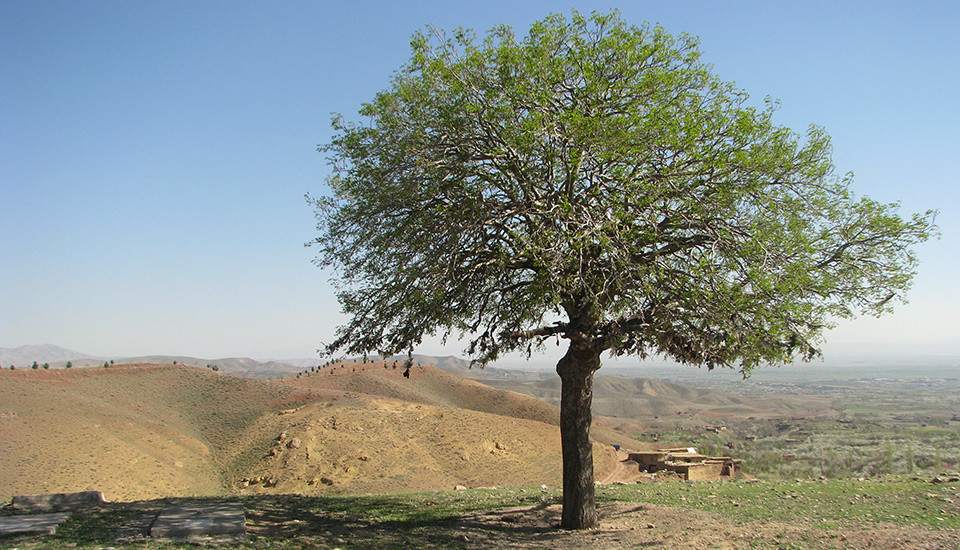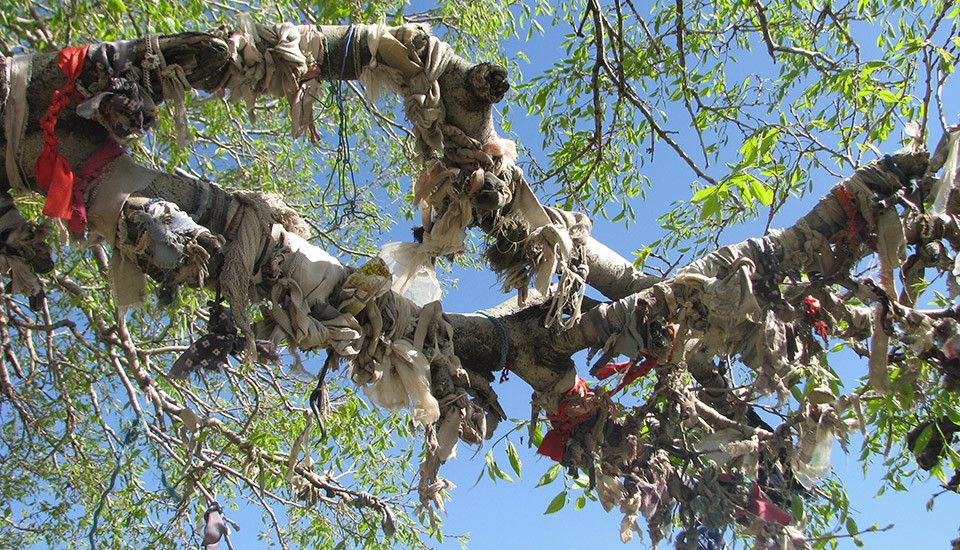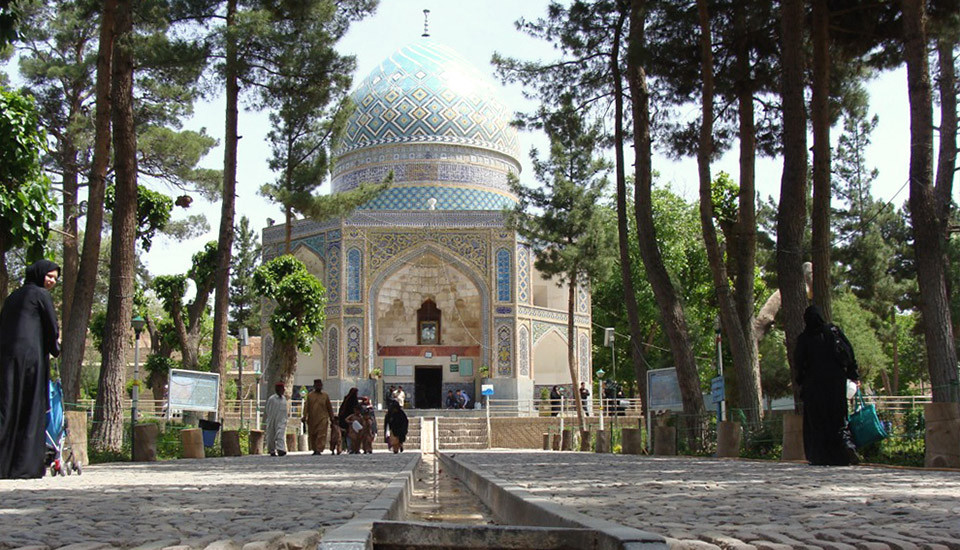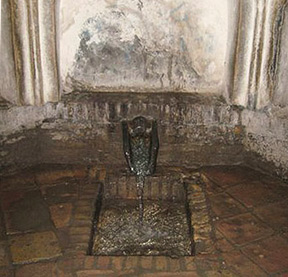Neyshābūr гэта горад на паўночным усходзе Ірана. Вялікая яго частка знаходзіцца ў шырокай раўніне, акружанай пагоркамі і гарамі. Існуюць розныя святых прыродных аб'ектаў у пасёлку, ад святыя дрэвы і святыя крыніцы ў святы валун і святыя сады. Плошча дамоў некалькі эндэмічных відаў раслін і жывёл. Ён таксама змяшчае ахоўныя тэрыторыі і экатурыстычныя напрамкі, такія як вадаспады, спружыны, Рэкі і вока лоўлі геаграфічныя асаблівасці, як горныя вяршыні. Клімат паўзасушлівы да сухога з сярэднегадавой колькасцю ападкаў 300 мм.
Нягледзячы на тое, што гэтыя ўчасткі ахоўваюцца мясцовымі суполкамі, іх будучыня знаходзіцца пад пагрозай урбанізацыі, рост насельніцтва, развіццё інфраструктуры і турызму.
Абаронены
Захавальнікі
Мясцовыя жыхары паважаюць прыродныя асаблівасці, паколькі яны маюць карані ў іх рэлігійных перакананняў. Qadamgah ў Neyshābūr напрыклад,, з'яўляецца фарсі сад, дзе прырода была прасякнута духоўных каштоўнасцей. Ён змяшчае асабняк, дрэвы, басейны і патокі. Адна са сцен асабняка ўтрымлівае чорны камень, на якім два сляды былі выразаныя. Людзі лічаць, што гэтыя адбіткі належаць да 8 імама шыітаў, мужчынскі духоўны лідэр лічыцца нашчадкам Мухамеда, чароўна прызначаны для кіраўніцтва людзей. Слова Qadamgah азначае след і ставіцца да гэтага апавядання.
Гісторыя Кадамгі як святога месца ўзыходзіць да даісламскага перыяду. Хаця яго першапачатковае прызначэнне невядома, гэта гістарычна звязана з сасанідскім прынцам Шахпурам Касрай, а таксама імаму Алі і імаму Рэзе. Кажуць, што ў 921 AD Імам Рэза спыніўся ў садзе па дарозе з Медыны ў Марв. У той момант, калі ён хацеў зрабіць абмыванне, з-пад зямлі выбілася крыніца. З тых часоў крыніца лічыцца святой, і людзі вераць, што гэтая вада мае гаючыя ўласцівасці.
Адны платаны (Plantanus sp.) на працягу стагоддзяў актыўна захоўваліся. Платаны ў Іране доўгі час лічыліся святымі з-за цені, якую яны ствараюць, іх велічыня і іх зялёны выгляд. Па ўсім Іране некаторыя платаны захоўваюцца на працягу многіх стагоддзяў. Легенды і павер'і аб некаторых асобніках прымусілі людзей трымацца далей ад іх. Доўгі платан у вёсцы Нейшабур, напрыклад, захоўваецца мясцовымі жыхарамі, таму што яны вераць, што калісьці чалавек страціў сваю сям'ю з-за таго, што яе галінкі зламаліся.
Мясцовыя жыхары па-ранейшаму захоўваюць малавядомыя святыні, якія не маюць юрыдычнай аховы. Значэнні такіх сайтах вучаць маладое пакаленне і рэлігійных цырымоній і практык ажыццяўляецца супольна, як гэта было на працягу стагоддзяў. Такім чынам,, Наступнае пакаленне вучыцца, каб абараніць іх.
Хоць ёсць афіцыйная стратэгія кіравання, людзі імкнуцца абараняць свае сайты. Некаторыя рэалізуюць кароткатэрміновыя меры на мясцовым узроўні. Сярод шырокага спектру планаў, якія выконваюцца, напрыклад, вакол дрэва жаданняў створаны парк і развіты турыстычныя паслугі.
Дзеянне
Мясцовыя жыхары і рэлігійныя інстытуты працягваюць свае спрадвечныя звычаі. Мясцовыя аддзяленні а Культурная спадчына, Рамёствы і турызм зарэгістраваць дрэвы-даўгавечнікі ў якасці помнікаў прыроды рэспубліканскага значэння. Нацыянальныя помнікі прыроды параўнальна невялікія, цікавы, унікальны, выключны, нетрадыцыйныя і незаменныя з’явы калекцый раслін і жывёл, якія маюць навук, гістарычнае або прыроднае значэнне. Ахоўныя меры ў гэтых раёнах гарантуюць іх устойлівае некамерцыйнае выкарыстанне.
Існуе таксама нацыянальны план інвентарызацыі і захавання доўгажывучых дрэў пад наглядам Лясы, Арганізацыя кіравання арэалам і водападзелам Ірана. Апошнія даследаванні Мар'ям Кабіры звяртаюць увагу на значэнне духоўных каштоўнасцей, якія маюць гэтыя і іншыя святыні для аховы прыроды.
Палітыкі і правы
У заканадаўстве Ірана няма згадкі святых прыродных аб'ектаў да гэтага часу. Некаторыя святых прыродных аб'ектаў былі афіцыйна захоўваецца, таму што яны знаходзяцца ў ахоўных раёнах або ў нацыянальны помнік. Іншыя былі адмыслова зарэгістраваныя ў якасці нацыянальных прыродных помнікаў. Культурнай спадчыны і дэпартамента навакольнага асяроддзя ўлады маюць права голасу ў абарону нацыянальных прыродных помнікаў. Яны выступаюць у асноўным для рэдкіх відаў флоры і фауны і выдатныя утварэнняў зямлю, пейзажы або нават векавыя дрэвы. Затым яны ўзятыя пад абарону шляхам прызначэння падыходнага па перыметры.
Кааліцыя
Некаторыя святыні раёна знаходзяцца пад наглядам Фонды і дабрачынныя арганізацыі (адказвае за дары і святыя месцы, такія як мячэці і святыні) і апякунскі савет з мясцовых жыхароў. The Культурная спадчына, Рамёствы і турыстычная арганізацыя нясе адказнасць за рэгістрацыю і кіраванне гістарычнымі помнікамі і нацыянальнымі прыроднымі помнікамі.
Крок, напрыклад, быў зарэгістраваны такім чынам, Але гэта таксама пад кіраўніцтвам сродкаў і дабрачыннай арганізацыі Ірана і мясцовага савета папячыцеля. Як у выпадку з Кадамгай, Калі сайт мае як культурныя, так і духоўныя каштоўнасці, гэтыя арганізацыі супрацоўнічаюць у захаванні і кіраванні сайтам.
Захаванне інструменты
Былі створаны крытэрыі захавання, і гэтыя крытэрыі прывялі да карт раёнаў у мястэчку Нейшабур, якія маюць патрэбу ў прыярытэце. Некаторыя рэкамендацыі дадаткова былі сфармуляваны ў гэтай дысертацыі, што можа дапамагчы з першапачатковымі крокамі для планавання палітычнага парадку дня і распрацоўкі крытэрыяў і паказчыкаў нацыянальнага помніка прыроды, які ўлічвае духоўныя каштоўнасці.
Вынікі
Святыя прыродныя месцы як частка біякультурнай разнастайнасці на працягу стагоддзяў ахоўваліся мясцовымі вераваннямі і каштоўнасцямі. У наш час гэтыя сайты знаходзяцца пад пагрозай па розных прычынах. Калі яны хочуць выжыць, бягучыя меры павінны быць падмацаваныя прававой абароны. Для гэтай мэты, выкарыстоўваючы комплексны падыход, заснаваны на сумесным крытэрыяў і палітыкі ў галіне прыроды і культуры можа згуляць ключавую ролю ў захаванні святых прыродных аб'ектаў. Кабірыя хэнд (2011) вызначаны такія крытэры для захавання святых прыродных аб'ектаў у пасёлку Neyshābūr.
- Бахар, M. (1995) Ад міфа да гісторыі. Выданне Cheshmeh, Тэгеран, Іран.
- Данешдуост, J. (1992) Персідскі сад. Часопіс Асар, Т.12: 48-52.
- Кабірыя хэнд, M. (2011) Ацэнка зямель для захавання прыродных аб'ектаў з духоўнымі каштоўнасцямі, тэматычнае даследаванне пасёлка Нейшабур. Дысертацыя магістра навук у Тэгеранскім універсітэце, дарагія, Іран.
- Тахеры, A. (2009) Даведнік па турызму ў Нейшабуры. Абаршахр, Мешхед, Іран.
- Адчуваць, B (2005) Комплекс фінансавых лясоў, Часопісы, выпуск7:86-93.







